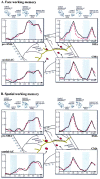Sustained activity in the medial wall during working memory delays
- PMID: 9801381
- PMCID: PMC6792871
- DOI: 10.1523/JNEUROSCI.18-22-09429.1998
Sustained activity in the medial wall during working memory delays
Abstract
We have taken advantage of the temporal resolution afforded by functional magnetic resonance imaging (fMRI) to investigate the role played by medial wall areas in humans during working memory tasks. We demarcated the medial motor areas activated during simple manual movement, namely the supplementary motor area (SMA) and the cingulate motor area (CMA), and those activated during visually guided saccadic eye movements, namely the supplementary eye field (SEF). We determined the location of sustained activity over working memory delays in the medial wall in relation to these functional landmarks during both spatial and face working memory tasks. We identified two distinct areas, namely the pre-SMA and the caudal part of the anterior cingulate cortex (caudal-AC), that showed similar sustained activity during both spatial and face working memory delays. These areas were distinct from and anterior to the SMA, CMA, and SEF. Both the pre-SMA and caudal-AC activation were identified by a contrast between sustained activity during working memory delays as compared with sustained activity during control delays in which subjects were waiting for a cue to make a simple manual motor response. Thus, the present findings suggest that sustained activity during working memory delays in both the pre-SMA and caudal-AC does not reflect simple motor preparation but rather a state of preparedness for selecting a motor response based on the information held on-line.
Figures




References
-
- Anderson TJ, Jenkins IH, Brooks DJ, Hawken MB, Frackowiak RSJ, Kennard C. Cortical control of saccades and fixation in man: a PET study. Brain. 1994;117:1073–1084. - PubMed
-
- Bates JF, Goldman-Rakic PS. Prefrontal connections of medial motor areas in the rhesus monkey. J Comp Neurol. 1993;336:211–228. - PubMed
-
- Braver TS, Cohen JD, Nystrom LE, Jonides J, Smith EE, Noll DC. A parametric study of prefrontal cortex involvement in human working memory. NeuroImage. 1997;5:49–62. - PubMed
-
- Clark VP, Maisog JM, Haxby JV. fMRI studies of face memory using random stimulus sequences. J Neurophysiol. 1998;79:3257–3265. - PubMed
-
- Cohen JD, Perlstein WM, Braver TS, Nystrom LE, Noll DC, Jonides J, Smith EE. Temporal dynamics of brain activation during a working memory task. Nature. 1997;386:604–607. - PubMed
MeSH terms
LinkOut - more resources
Full Text Sources
